Odour Impact Assessment in a Changing Climate
Abstract
1. Introduction
2. Materials and Methods
3. Results
3.1. Stability Classes
3.2. Separation Distances
4. Discussion and Conclusions
Author Contributions
Funding
Data Availability Statement
Acknowledgments
Conflicts of Interest
References
- Leelőssy, Á.; Molnár, F., Jr.; Izsák, F.; Havasi, Á.; Lagzi, I.; Mészáros, R. Dispersion modeling of air pollutants in the atmosphere: A review. Cent. Euro. J. Geosci. 2014, 6, 257–278. [Google Scholar] [CrossRef]
- Brancher, M.; Griffiths, K.D.; Franco, D.; De MeloLisboa, H. A review of odour impact criteria in selected countries around the world. Chemosphere 2017, 168, 1531–1570. [Google Scholar] [CrossRef] [PubMed]
- Sommer-Quabach, E.; Piringer, M.; Petz, E.; Schauberger, G. Comparability of separation distances between odour sources and residential areas determined by various national odour impact criteria. Atmos. Environ. 2014, 95, 20–28. [Google Scholar] [CrossRef]
- Piringer, M.; Knauder, W.; Petz, E.; Schauberger, G. Factors influencing separation distances against odour annoyance calculated by Gaussian and Langrangian dispersion models. Atmos. Environ. 2016, 140, 69–83. [Google Scholar] [CrossRef]
- Piringer, M.; Knauder, W.; Anders, I.; Andre, K.; Zollitsch, W.; Hörtenhuber, S.J.; Baumgartner, J.; Niebuhr, K.; Hennig-Pauka, I.; Schönhart, M.; et al. Climate change impact on the dispersion of airborne emissions and the resulting separation distances to avoid odour annoyance. Atmos. Environ. X 2019, 2, 100021. [Google Scholar] [CrossRef]
- Kottek, M.; Grieser, J.; Beck, C.; Rudolf, B.; Rubel, F. World map of the Köppen-Geiger climate classification updated. Meteorol. Z. 2006, 15, 259–263. [Google Scholar] [CrossRef]
- Rockel, B.; Will, A.; Hense, A. The Regional Climate Model COSMO-CLM (CCLM). Meteorol. Z. 2008, 17, 347–348. [Google Scholar] [CrossRef]
- Dee, D.P.; Uppala, S.M.; Simmons, A.J.; Berrisford, P.; Poli, P.; Kobayashi, S.; Andrae, U.; Balmaseda, M.A.; Balsamo, G.; Bauer, P.; et al. The ERA-Interim reanalysis: Configuration and performance of the data assimilation system. Q. J. R. Meteorol. Soc. 2011, 137, 553–597. [Google Scholar] [CrossRef]
- Smiatek, G.; Kunstmann, H.; Senatore, A. EURO-CORDEX regional climate model analysis for the Greater Alpine Region: Performance and expected future change. J. Geophys. Res. Atmos. 2016, 121, 7710–7728. [Google Scholar] [CrossRef]
- Jacob, D.; Petersen, J.; Eggert, B.; Alias, A.; Bøssing Christensen, O.; Bouwer, L.M.; Braun, A.; Colette, A.; Déqué, M.; Georgievski, G.; et al. EURO-CORDEX: New high-resolution climate change projections for European impact research. Reg. Environ. Chang. 2014, 14, 563. [Google Scholar] [CrossRef]
- Janicke Consulting. Dispersion Model LASAT Version 3.4, Reference Book; Janicke Consulting Environmental Physics: Überlingen, Germany, 2019. [Google Scholar]
- Bundesministerium für Umwelt, Naturschutz und Reaktorsicherheit. Erste Allgemeine Verwaltungsvorschrift zum Bundes–Immissionsschutzgesetz (Technische Anleitung zur Reinhaltung der Luft—TA Luft); Bundesministerium für Umwelt, Naturschutz und Reaktorsicherheit: Berlin, Germany, 2002.
- EPA. Meteorological Monitoring Guidance for Regulatory Modeling Applications; United States Environmental Protection Agency (EPA): Washington, DC, USA, 2000.
- VDI. Emissions and Immissions from Animal Husbandry—Housing Systems and Emissions—Pigs, Cattle, Poultry, Horses; VDI 3894 Part 1; Verein Deutscher Ingenieure, VDI Verlag: Düsseldorf, Germany, 2011. [Google Scholar]
- Zahn, J.A.; DiSpirito, A.A.; Do, Y.S.; Brooks, B.E.; Cooper, E.E.; Hatfield, J.L. Correlation of human olfactory responses to airborne concentrations of malodorous volatile organic compounds emitted from swine effluent. J. Environ. Qual. 2001, 30, 624–634. [Google Scholar] [CrossRef] [PubMed]
- Liu, D. Application of PTR-MS for Optimization of Odour Removal from Intensive Pig Production with Emphasis on Biofiltration; Department of Engineering—Biological and Chemical Engineering, Aarhus University: Aarhus, Denmark, 2013. [Google Scholar]
- GOAA. Guideline on Odour in Ambient Air. In Detection and Assessment of Odour in Ambient Air, 2nd ed.; GOAA: Berlin, Germany, 2008. [Google Scholar]
- Piringer, M.; Knauder, W.; Petz, E.; Schauberger, G. A comparison of separation distances against odour annoyance calculated with two models. Atmos. Environ. 2015, 116, 22–35. [Google Scholar] [CrossRef]
- Brancher, M.; Knauder, W.; Piringer, M.; Schauberger, G. Temporal variability in odour emissions: To what extent this matters for the assessment of annoyance using dispersion modelling. Atmos. Environ. X 2020, 5, 100054. [Google Scholar] [CrossRef]
- Schauberger, G.; Piringer, M.; Heber, A.J. Odour emission scenarios for fattening pigs as input for dispersion models: A step from an annual mean value to time series. Agric. Ecosyst. Environ. 2014, 93, 108–116. [Google Scholar] [CrossRef]
- Baumann-Stanzer, K.; Piringer, M.; Polreich, E.; Hirtl, M.; Petz, E.; Bügelmayer, M. User experience with model validation exercises. Croat. Meteorol. J. 2008, 43, 52–56. [Google Scholar]
- Piringer, M.; Baumann-Stanzer, K. Selected results of a model validation exercise. Adv. Sci. Res. 2009, 3, 13–16. [Google Scholar] [CrossRef][Green Version]
- Baumann-Stanzer, K.; Piringer, M. Validation of regulatory micro-scale air quality models: Modeling odour dispersion and built-up areas. World Rev. Sci. Technol. Sustain. Dev. 2011, 8, 203–213. [Google Scholar] [CrossRef]
- Di Sabatino, S.; Buccolieri, R.; Olesen, H.R.; Ketzel, M.; Berkowicz, R.; Franke, J.; Schatzmann, M.; Schlünzen, K.H.; Leitl, B.; Britter, R.; et al. COST 732 in practice: The MUST model evaluation exercise. Int. J. Environ. Pollut. 2011, 44, 403–418. [Google Scholar] [CrossRef]
- Schauberger, G.; Hennig-Pauka, I.; Zollitsch, W.; Hörtenhuber, S.J.; Baumgartner, J.; Niebuhr, K.; Piringer, M.; Knauder, W.; Anders, I.; Andre, K.; et al. Efficacy of adaptation measures to alleviate heat stress in confined livestock buildings in temperate climate zones. Biosyst. Eng. 2020, 200, 157–175. [Google Scholar] [CrossRef]
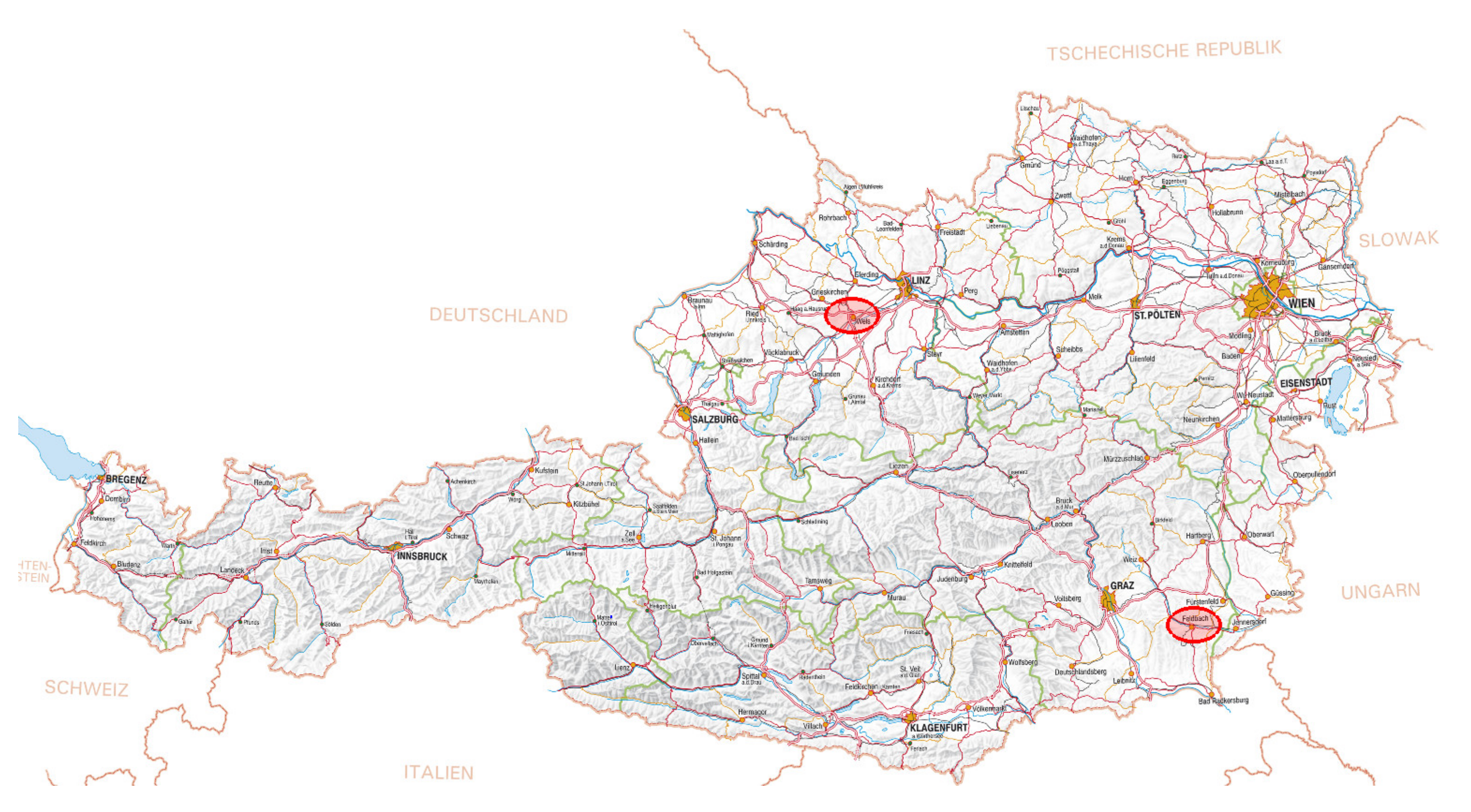

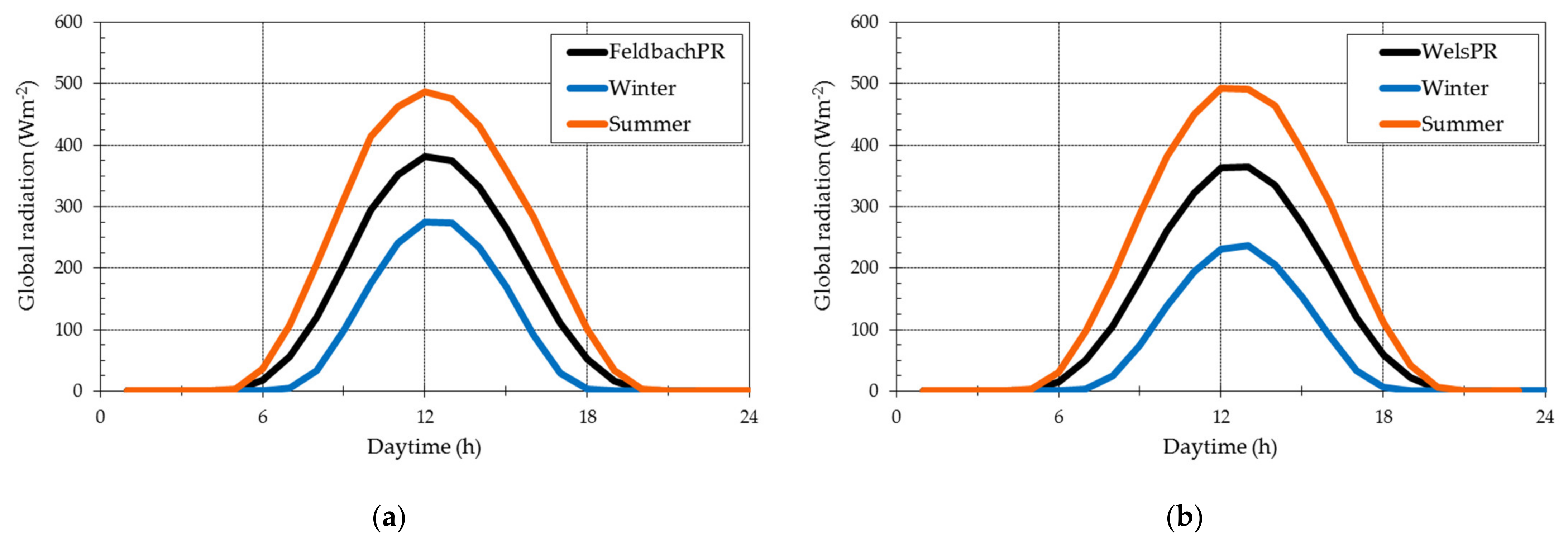
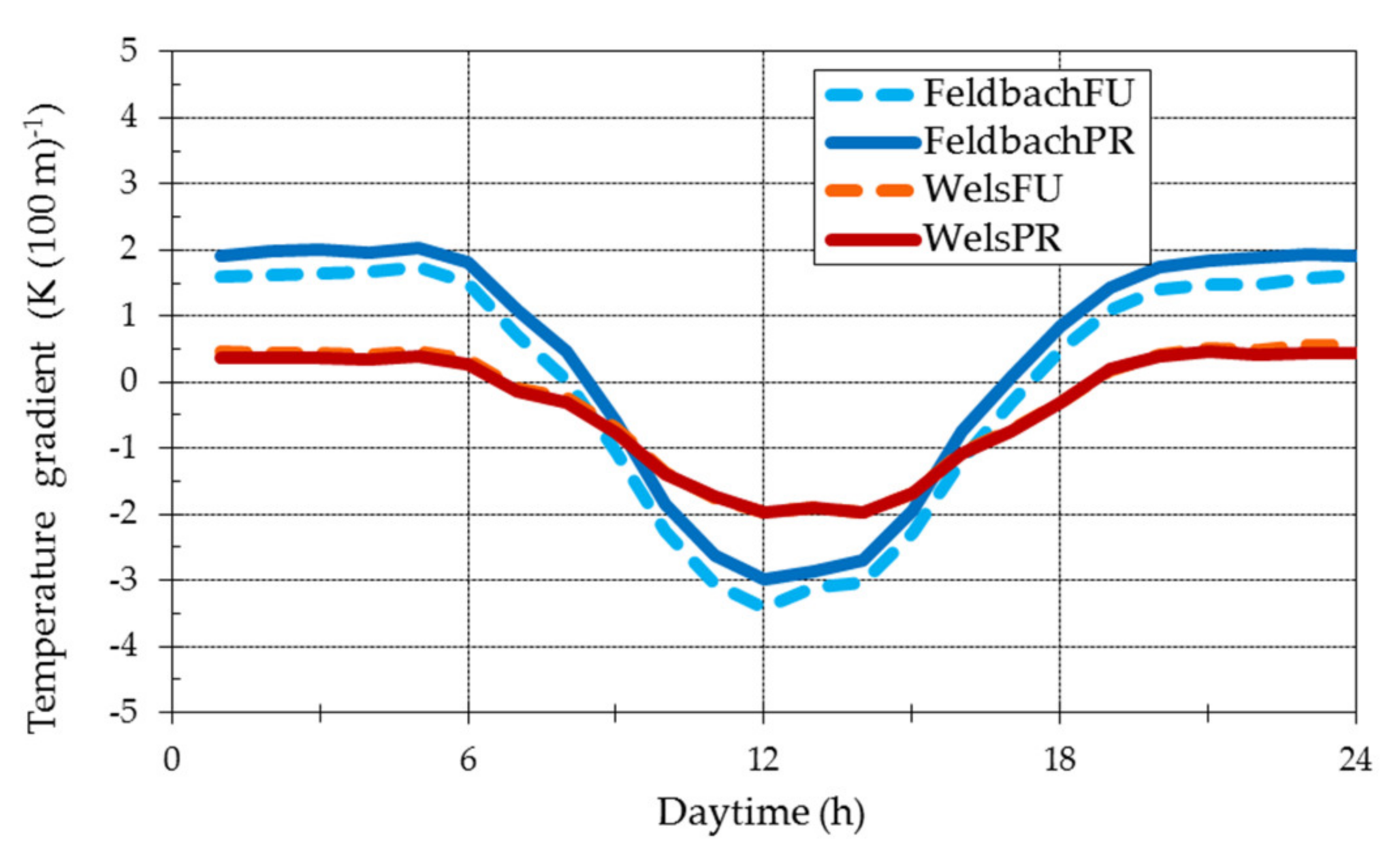
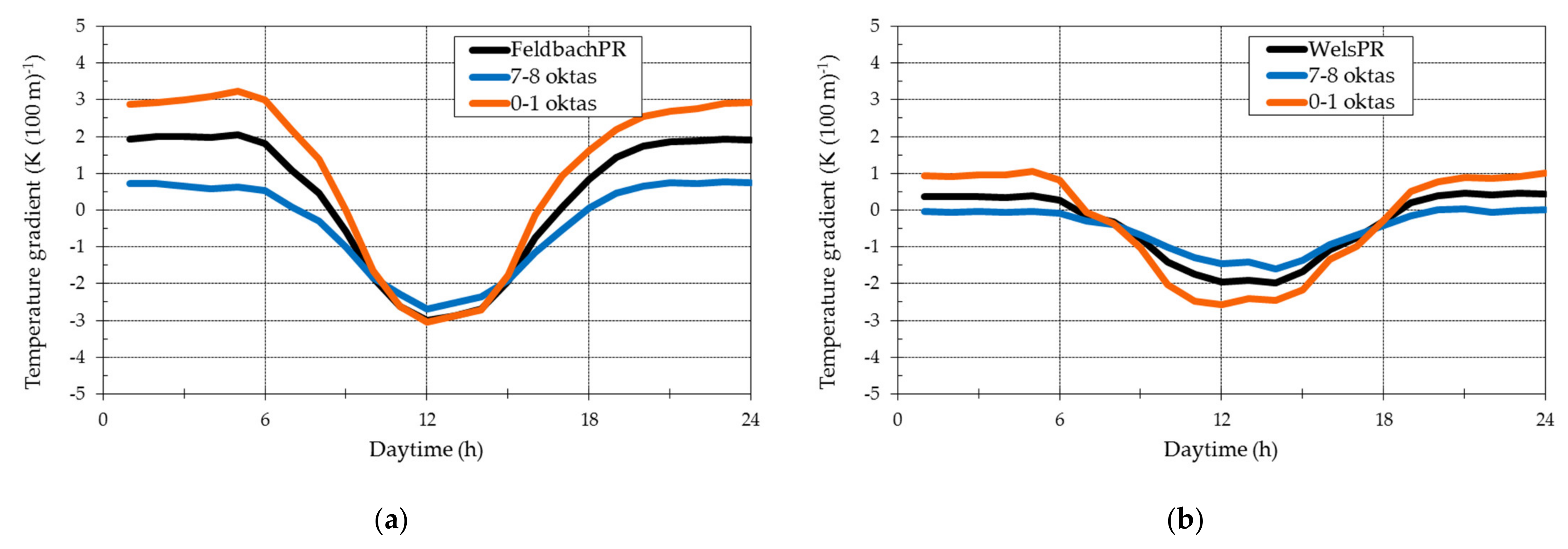
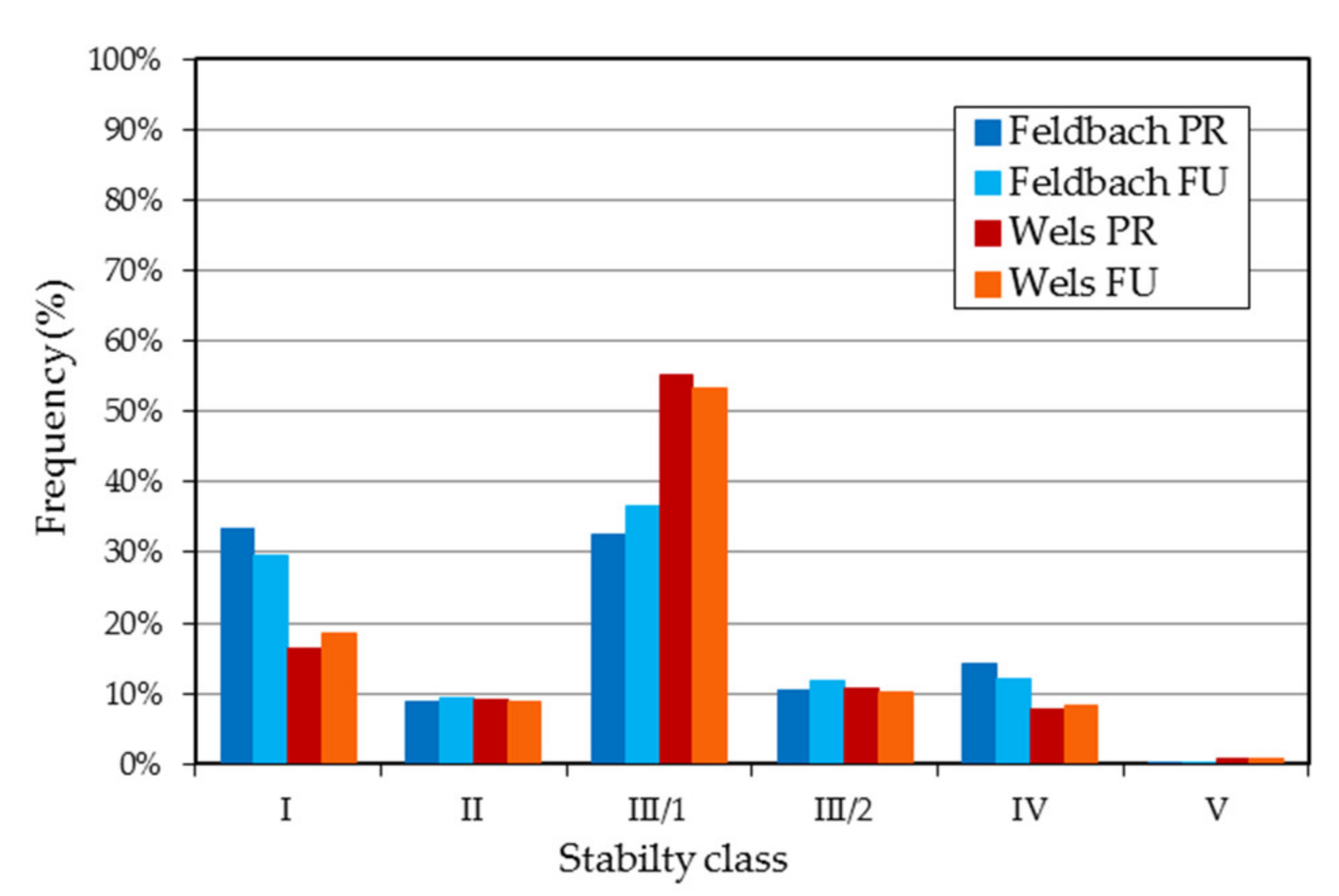
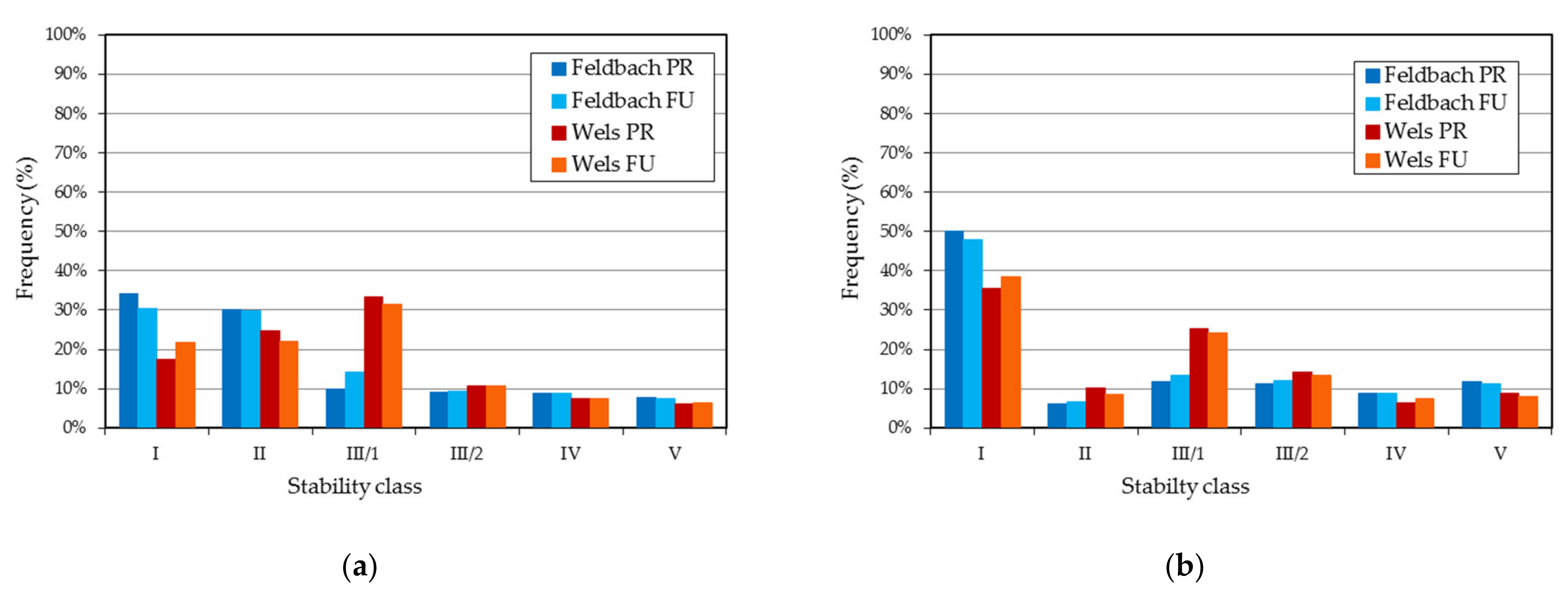
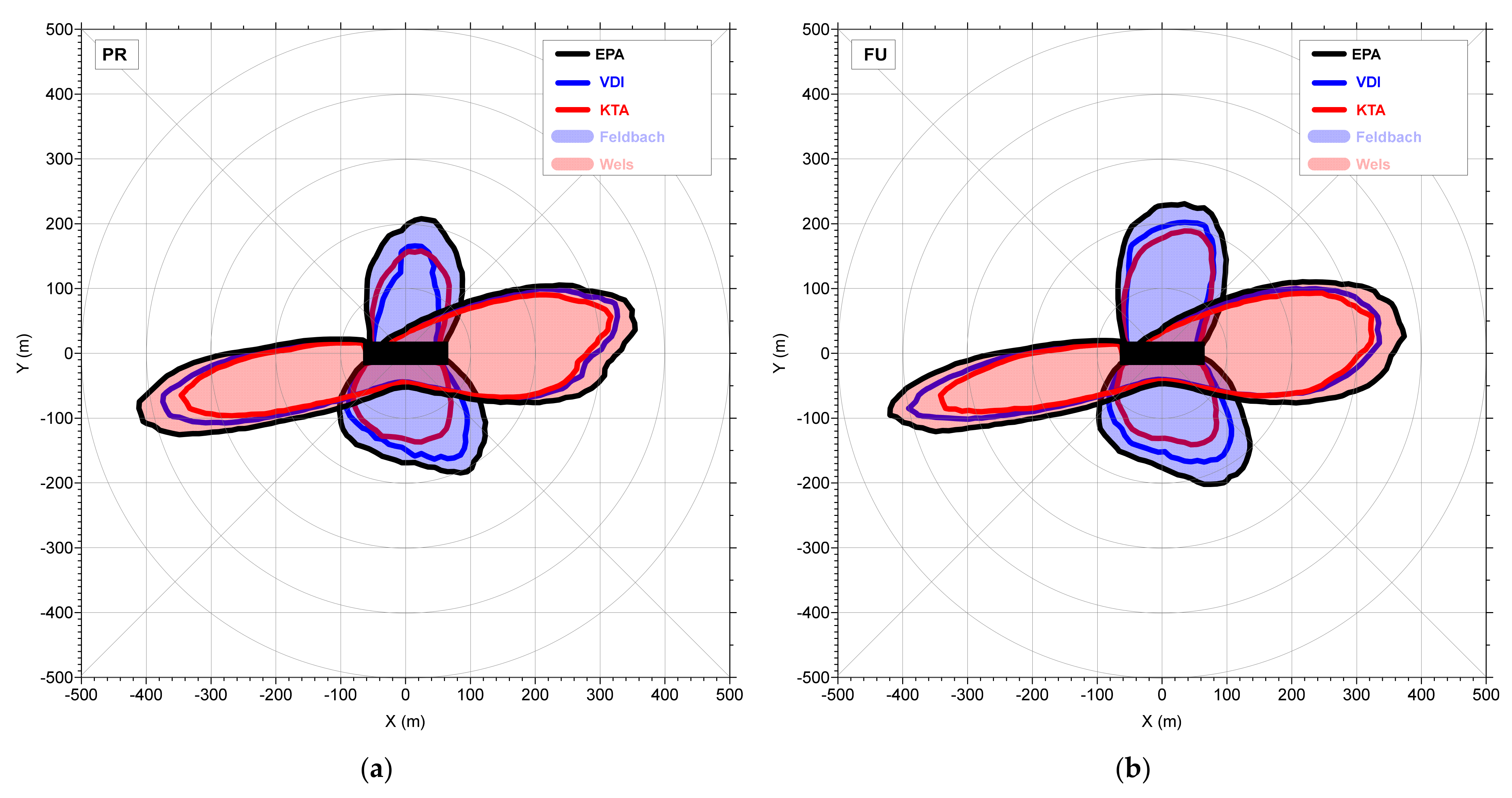
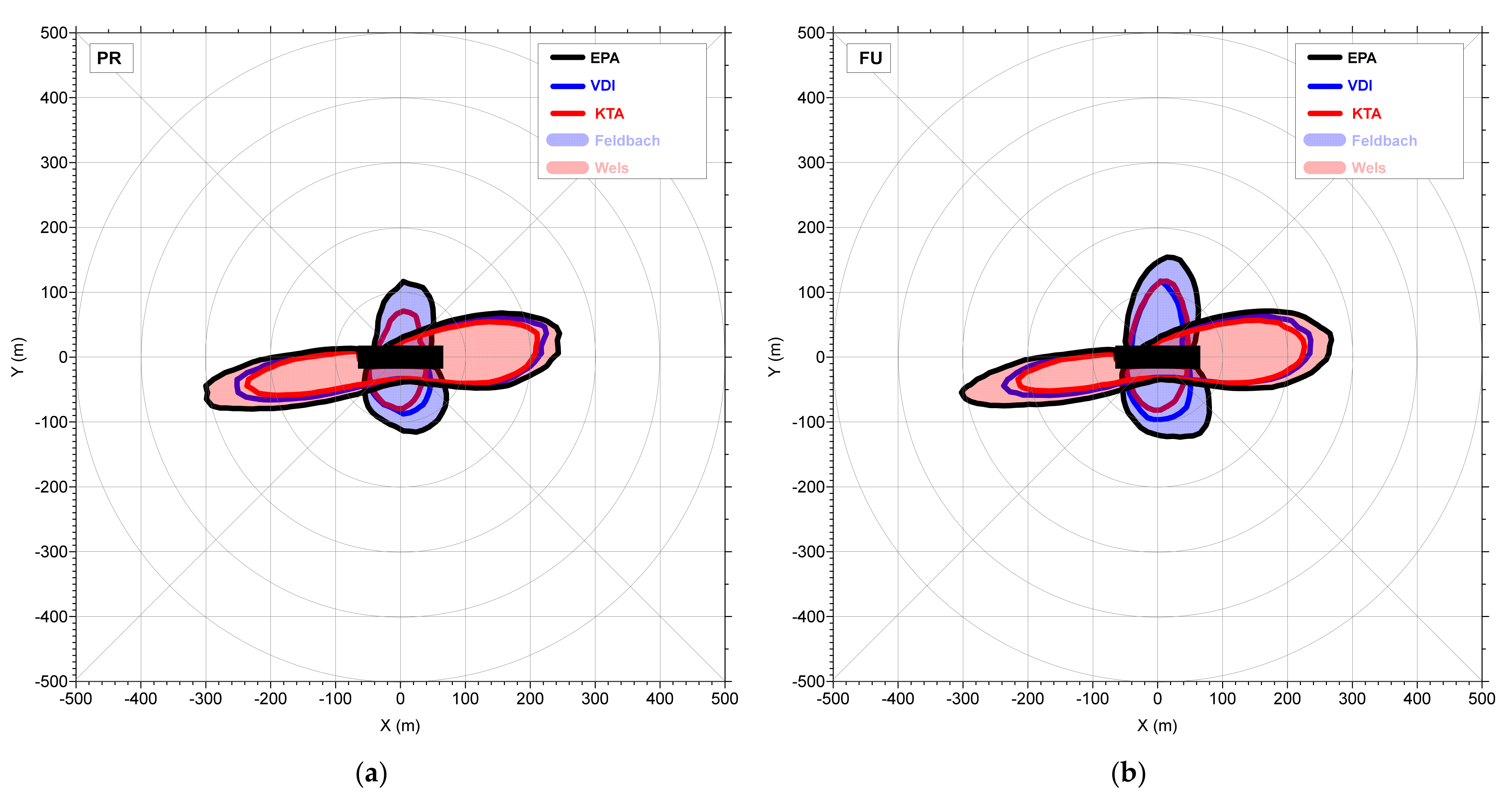
| DAYTIME (Global Radiation ≥ 20 Wm−2) | ||||
| Global Radiation (Wm−2) | ||||
| Wind Speed (ms−1) | ≥925 | 925–675 | 675–175 | 175–20 |
| <2 | V | V | IV | III/1 |
| 2–2.9 | V | IV | III/2 | III/1 |
| 3–4.9 | IV | IV | III/2 | III/1 |
| 5–5.9 | III/2 | III/2 | III/1 | III/1 |
| ≥6 | III/2 | III/1 | III/1 | III/1 |
| NIGHTTIME (Global Radiation < 20 Wm−2) | ||||
| Vertical Temperature Gradient (K(100 m)−1) | ||||
| Wind Speed (ms−1) | <0 | ≥0 | ||
| <2 | II | I | ||
| 2–2.9 | III/1 | II | ||
| ≥3 | III/1 | III/1 | ||
| Wind Speed υ10 at 10 m Height (z0 = 0.1 m) | Night-Time | Daytime | |||
|---|---|---|---|---|---|
| Total Cloud Cover | Total Cloud Cover | ||||
| in ms−1 | 0/8 to 6/8 | 7/8 to 8/8 | 0/8 to 2/8 | 3/8 to 5/8 | 6/8 to 8/8 |
| ≤1.2 | I | II | IV | IV | IV |
| 1.3 to 2.3 | I | II | IV | IV | III/2 |
| 2.4 to 3.3 | II | III/1 | IV | IV | III/2 |
| 3.4 to 4.3 | III/1 | III/1 | IV | III/2 | III/2 |
| ≥4.4 | III/1 | III/1 | III/2 | III/1 | III/1 |
| Wind Speed υ10 at 10 m Height | Radiation Balance in Wm−2 | ||||
|---|---|---|---|---|---|
| Limits of Categories | |||||
| In ms−1 | A/B | B/C | C/D | D/E | E/F |
| 0 to 0.9 | 214 | 125 | 60 | −2 | −9 |
| 1.0 to 1.9 | 214 | 126 | 60 | −4 | −13 |
| 2.0 to 2.9 | 301 | 162 | 60 | −6 | −21 |
| 3.0 to 3.9 | 400 | 232 | 63 | −12 | −34 |
| 4.0 to 4.9 | 495 | 305 | 67 | −28 | −55 |
| 5.0 to 5.9 | ─ | 376 | 84 | −55 | ─ |
| 6.0 to 6.9 | ─ | 450 | 108 | ─ | ─ |
| 7.0 to 7.9 | ─ | ─ | 150 | ─ | ─ |
| 8.0 to 9.9 | ─ | ─ | 240 | ─ | ─ |
| ≥10.0 | All values category D | ||||
| Example: | |||||
| If the conditions 2.0 ms−1 ≤ u10 < 3.0 ms−1 and 162 Wm−2 ≥ radiation balance > 60 Wm−2 were fulfilled, then category C was used. | |||||
| Stack height | (m) | 5.0 |
| Stack diameter | (m) | 1.88 |
| Number of stacks | 9 | |
| Outlet air velocity | (ms−1) | 2.0 |
| Volume flow rate | (m3 h−1) | 180,000 |
| Temperature | (°C) | 0 |
| Odour emission rate | (ouEs−1) | 13,500 |
| Concentration | (ouEm−3) | 270 |
Publisher’s Note: MDPI stays neutral with regard to jurisdictional claims in published maps and institutional affiliations. |
© 2021 by the authors. Licensee MDPI, Basel, Switzerland. This article is an open access article distributed under the terms and conditions of the Creative Commons Attribution (CC BY) license (https://creativecommons.org/licenses/by/4.0/).
Share and Cite
Piringer, M.; Knauder, W.; Baumann-Stanzer, K.; Anders, I.; Andre, K.; Schauberger, G. Odour Impact Assessment in a Changing Climate. Atmosphere 2021, 12, 1149. https://doi.org/10.3390/atmos12091149
Piringer M, Knauder W, Baumann-Stanzer K, Anders I, Andre K, Schauberger G. Odour Impact Assessment in a Changing Climate. Atmosphere. 2021; 12(9):1149. https://doi.org/10.3390/atmos12091149
Chicago/Turabian StylePiringer, Martin, Werner Knauder, Kathrin Baumann-Stanzer, Ivonne Anders, Konrad Andre, and Günther Schauberger. 2021. "Odour Impact Assessment in a Changing Climate" Atmosphere 12, no. 9: 1149. https://doi.org/10.3390/atmos12091149
APA StylePiringer, M., Knauder, W., Baumann-Stanzer, K., Anders, I., Andre, K., & Schauberger, G. (2021). Odour Impact Assessment in a Changing Climate. Atmosphere, 12(9), 1149. https://doi.org/10.3390/atmos12091149








